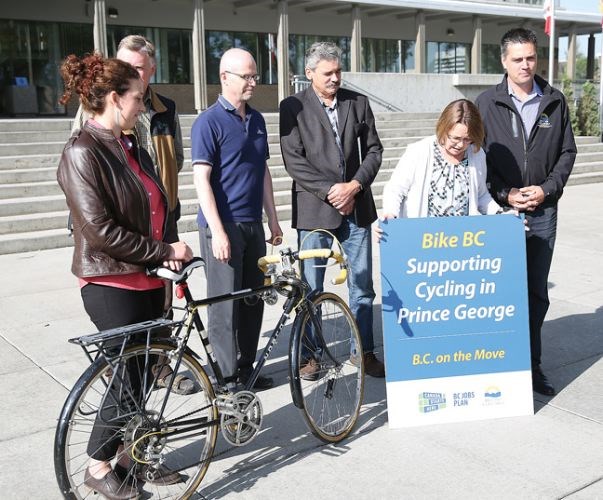A provincial grant will help pave the way to give the city's cyclists some breathing room.
On Thursday morning, Prince George MLAs Shirley Bond, Mike Morris and Transportation Minister Todd Stone announced the provincial government was contributing $250,000 to improving bike lanes in the city.
The money will match a municipal investment towards improving street markings and signs along the roughly 36 kilometres of cycling lanes throughout Prince George.
City council and city residents have made it clear to government representatives that they value alternative transportation, said Bond.
The existing bike lanes don't function properly because they're either not clearly marked as such or there are vehicles parked in them, said Coun. Jillian Merrick.
Improving cycling infrastructure was a major platform for Merrick - a former president of the Prince George Cycling Club - when she campaigned for council last fall.
Merrick said she will be bringing to council a motion to have vehicles prohibited from parking in bike lanes.
"There's no such thing as a dual purpose bike lane-parking lot. They're mutually exclusive uses," Merrick said. "You can't have stopped vehicles in the middle of a bike lane, just as you can't have stopped bikes in the middle of a vehicle lane. It just doesn't make for a proper passageway."
There are areas of the city where even the most seasoned cyclists feel unsafe, said Heather Sapergia, president of the Prince George Cycling Club, who had a hand in the grant application that led to Thursday's announcement.
"This, I think, is really going to improve the safety for cycling and the visibility for cycling in the city," Sapergia said.
"I think it will remind car drivers that they're not the only ones on the road."
Just that morning, on the way to city hall for the announcement, Sapergia said she had a close call with something called dooring - where drivers stopped in a bike lane open their vehicle doors without checking to see if a cyclist is there.
A 38-year-old cyclist died last week after crashing into a car door that opened suddenly in Kelowna.
"As a cyclist, when I see cars parked in the cycling lane, I ride farther out from there. So I'm putting myself right in the midst of the traffic lane, but I feel it's safer than riding close to the cars in the bike lane," Sapergia said.
The work will likely start next year, said city interim public works director Dave Dyer. Before that happens, the city will have to look at the arterial routes, such as Ospika Boulevard, to see how to properly accommodate the bike network as well as reach out to stakeholders, such as property owners who have property fronting those roads.
Provincial programs such as BikeBC - which shares the cost with local governments for cycling projects - are useful for delving into the city's active transportation plan, Dyer said.
"The grants are 50-50, so we could leverage some of the work in our paving program as well, and transition to a smoother process in capital planning," he said.



